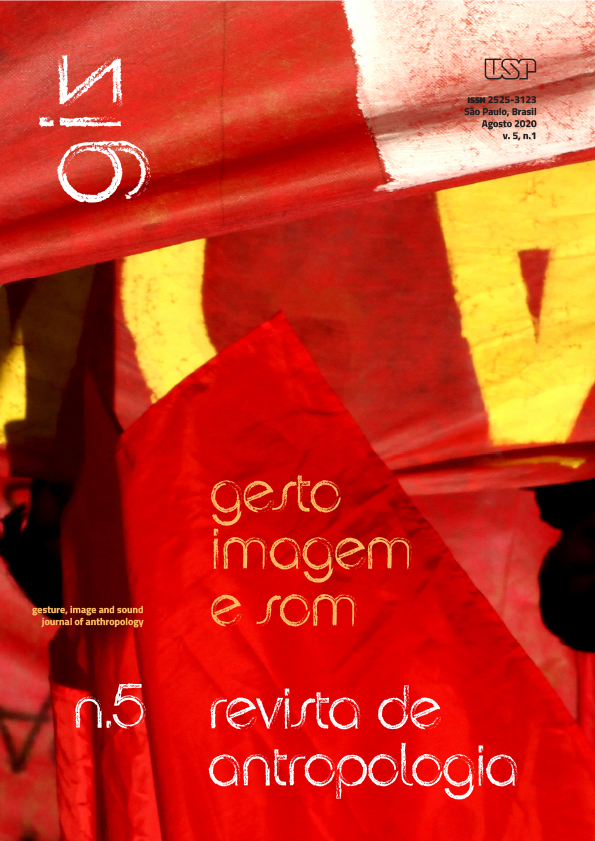Filmes como coisas na Índia colonial
DOI:
https://doi.org/10.11606/issn.2525-3123.gis.2020.171664Palavras-chave:
Antropologia visual, Cinema colonial, ÍndiaResumo
Este artigo argumenta que um produto visual também é material, no sentido de que objetos visuais (mesmo digitais) podem circular pelos mais variados espaços e, dependendo do contexto, podem adquirir ou expressar propriedades muito diferentes. Este artigo baseia-se em pesquisas conduzidas pelo autor em arquivos de filmes na Índia e no Reino Unido. O objetivo é mostrar que os filmes de não ficção (e a duração das filmagens) filmados por oficiais coloniais britânicos e visitantes da Índia na primeira metade do século XX formam “documentos” visuais que se baseiam em convenções fotográficas e filmes anteriores. Simultaneamente, o cinema de ficção indiano toma forma, com o trabalho pioneiro de DG Phalke. Os cinemas usam os mesmos materiais, possivelmente os mesmos tipos de câmera, porém sem intersectarem-se. Conclui-se que os filmes do período citado e posterior auxiliam entender as relações visuais entre o povo indiano como sujeito e os colonizadores britânicos.
Downloads
Referências
Banks, Marcus and David Zeitlyn. 2015. Visual methods in social research. London: Sage.
Bayly, Christopher A. 1986. The origins of swadeshi (home industry): cloth and Indian society: 1700-1930. In The social life of things: commodities in cultural perspective, ed. Arjun Appadurai, 285-322. Cambridge: Cambridge University Press.
Benjamin, Walter. 1992. The work of art in the age of mechanical reproduction. In Illuminations, ed. Hannah Arendt, 211-244. London: Fontana.
Chabria, Suresh. 1994. Before our eyes: a short history of India’s silent cinema. In Light of Asia: Indian silent cinema 1912-1934, eds. Suresh Chabria and Paolo Cherchi Usai, 3-24. New Delhi: Wiley Eastern.
Chabria, Suresh and Paolo Cherchi Usai, eds. 1994. Light of Asia: Indian silent cinema 1912-1934. New Delhi: Wiley Eastern.
Edwards, Elizabeth. 2001. Raw histories: photographs, anthropology and museums. Oxford: Berg.
Gutman, Judith. 1982. Through Indian eyes: 19th and early 20th century photography from India. New York: Oxford University Press.
Hamilton, Peter and Roger Hargreaves. 2001. The beautiful and the dammed: nineteenth-century portrait photography. London: National Portrait Gallery.
Kopytoff, Igor. 1986. The cultural biography of things: commoditization as process. In The social life of things: commodities in cultural perspective, ed. Arjun Appadurai, 64-92. Cambridge: Cambridge University Press.
Mirzoeff, Nicholas. 1999. An introduction to visual culture. London: Routledge.
Morphy, Howard and Marcus Banks. 1997. Introduction: rethinking visual anthropology. In Rethinking visual anthropology, eds. Marcus Banks and Howard Morphy, 1-35. London, New Haven: Yale University Press.
Phillips, Sandra S., Mark Haworth-Booth and Carol Squiers. 1997. Police pictures: the photograph as evidence. San Francisco: San Francisco Museum of Modern Art, Chronicle Books.
Pinney, Christopher. 1992. Montage, doubling and the mouth of god. In Ethnographic film aesthetics and narrative traditions: proceedings from NAFA 2, eds. Peter Ian Crawford and Jan K. Simonsen, 77-106. Aarhus: Intervention Press.
Pinney, Christopher. 1997. Camera Indica: the social life of Indian photographs. London: Reaktion Books.
Rajadhyaksha, Ashish. 1994. India’s silent cinema: “a viewer’s view”. In Light of Asia: Indian silent cinema 1912-1934, eds. Suresh Chabria and Paolo Cherchi Usai, 25-40. New Delhi: Wiley Eastern.
Rajadhyaksha, Ashish and Paul Willemen. 1994. Encyclopaedia of Indian cinema. London, New Delhi: British Film Institute, Oxford University Press.
Ruby, Jay. 2000. Picturing culture: explorations in film and anthropology. Chicago: University of Chicago Press.
Tarlo, Emma. 1996. Clothing matters: dress and identity in India. London: Hurst and Company.
Taylor, Lucien. 1998. “Visual anthropology is dead, long live visual anthropology”. American Anthropologist, vol. 100, no. 2: 534-537.
Thomas, Nicholas. 1991. Entangled objects: exchange, material culture, and colonialism in the Pacific. Cambridge, MA, London: Harvard University Press.
Vaughan, Megan. 1991. Curing their ills: colonial power illness. Stanford: Stanford University Press.
Downloads
Publicado
Edição
Seção
Licença
Autores que publicam nesta revista concordam com os seguintes termos:
- Autores mantém os direitos autorais e concedem à revista o direito de primeira publicação, com o trabalho simultaneamente licenciado sob a Licença Creative Commons Attribution que permite o compartilhamento do trabalho com reconhecimento da autoria e publicação inicial nesta revista para fins não comerciais.
- Autores têm autorização para assumir contratos adicionais separadamente, para distribuição não-exclusiva da versão do trabalho publicada nesta revista (ex.: publicar em repositório institucional ou como capítulo de livro), com reconhecimento de autoria e publicação inicial nesta revista.







